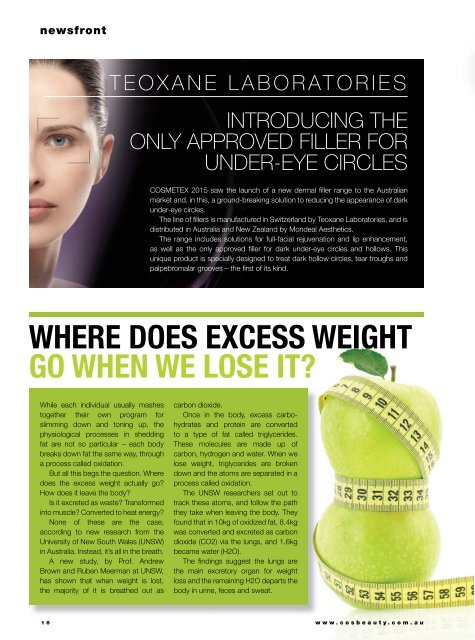Cosmetic Surgery and Beauty Magazine #68
Create successful ePaper yourself
Turn your PDF publications into a flip-book with our unique Google optimized e-Paper software.
newsfront<br />
TEOXANE LABORATORIES<br />
INTRODUCING THE<br />
ONLY APPROVED FILLER FOR<br />
UNDER-EYE CIRCLES<br />
COSMETEX 2015 saw the launch of a new dermal fi ller range to the Australian<br />
market <strong>and</strong>, in this, a ground-breaking solution to reducing the appearance of dark<br />
under-eye circles.<br />
The line of fi llers is manufactured in Switzerl<strong>and</strong> by Teoxane Laboratories, <strong>and</strong> is<br />
distributed in Australia <strong>and</strong> New Zeal<strong>and</strong> by Mondeal Aesthetics.<br />
The range includes solutions for full-facial rejuvenation <strong>and</strong> lip enhancement,<br />
as well as the only approved fi ller for dark under-eye circles <strong>and</strong> hollows. This<br />
unique product is specially designed to treat dark hollow circles, tear troughs <strong>and</strong><br />
palpebromalar grooves – the fi rst of its kind.<br />
WHERE DOES EXCESS WEIGHT<br />
GO WHEN WE LOSE IT?<br />
While each individual usually mashes<br />
together their own program for<br />
slimming down <strong>and</strong> toning up, the<br />
physiological processes in shedding<br />
fat are not so particular – each body<br />
breaks down fat the same way, through<br />
a process called oxidation.<br />
But all this begs the question. Where<br />
does the excess weight actually go?<br />
How does it leave the body?<br />
Is it excreted as waste? Transformed<br />
into muscle? Converted to heat energy?<br />
None of these are the case,<br />
according to new research from the<br />
University of New South Wales (UNSW)<br />
in Australia. Instead, it’s all in the breath.<br />
A new study, by Prof. Andrew<br />
Brown <strong>and</strong> Ruben Meerman at UNSW,<br />
has shown that when weight is lost,<br />
the majority of it is breathed out as<br />
carbon dioxide.<br />
Once in the body, excess carbohydrates<br />
<strong>and</strong> protein are converted<br />
to a type of fat called triglycerides.<br />
These molecules are made up of<br />
carbon, hydrogen <strong>and</strong> water. When we<br />
lose weight, triglycerides are broken<br />
down <strong>and</strong> the atoms are separated in a<br />
process called oxidation.<br />
The UNSW researchers set out to<br />
track these atoms, <strong>and</strong> follow the path<br />
they take when leaving the body. They<br />
found that in 10kg of oxidized fat, 8.4kg<br />
was converted <strong>and</strong> excreted as carbon<br />
dioxide (CO2) via the lungs, <strong>and</strong> 1.6kg<br />
became water (H2O).<br />
The fi ndings suggest the lungs are<br />
the main excretory organ for weight<br />
loss <strong>and</strong> the remaining H2O departs the<br />
body in urine, feces <strong>and</strong> sweat.<br />
18 www.cosbeauty.com.au


















